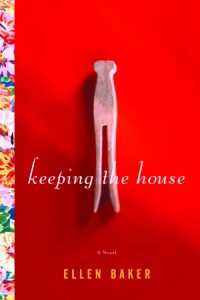The Story Behind the Book

After college, I spent a year working at a living history farm called The Homeplace, located near Dover, Tennessee. Here, I learned how to quilt by hand, and spent many hours gathered around the quilt frame with my co-workers trading stories and gossip. Then it was on to grad school at the University of Minnesota in Minneapolis. I was in the American Studies department, and my focus was on ideas about marriage, gender identity, sexuality, and nationalism during the early 20th century, especially during World War I. Leaving grad school with a master’s in 2000, I went back to Ephraim, Wisconsin, to work ¾-time at the historical society, determined to devote every bit of my spare time to revising my novel about the Mickelsons.
But on my spring break trip that March of 2000, I met Jay Baker, a soldier in the 101st Airborne, stationed at Fort Campbell, Kentucky. He was only 21, and told me before I left to drive back north that he had fallen for me. “Head over heels, I think is the term,” he said, with an endearing humility and a little laugh. Three months later, we were engaged, despite the 700 miles between us. We talked on the phone two hours every night. We counted down to our usually monthly visits. Each time we were together, the pain of separating became more extreme. “One of us is going to have to quit our job,” he said. “And if I quit mine, I go to jail!” So, in the summer of 2001, I did. I got hired back on at The Homeplace and moved down on Memorial Day, just three months before the wedding we’d already planned. Jay was scheduled to get out of the Army that December, so I planned to live with him in Kentucky for six months, doing a lot of writing and getting married in the midst of it.
We were married on September 8, 2001, near Ephraim. After 9/11, we went back to Kentucky. As every day we waited for word that Jay would be sent to Afghanistan, I learned that pinning my hopes to a soldier in a time like that was akin to running myself back and forth through an old wringer washer, day after day after day. I was living out the things I had studied in grad school: trapped in my wifely role, trying to be supportive and a “good citizen” in a time of war, and utterly, painfully helpless as a result. Though I didn’t make a conscious choice to write about this, in KEEPING THE HOUSE both Dolly and Wilma experience the same sort of helplessness – Dolly in the unwanted move to Pine Rapids and her consequent difficulties, and Wilma, more dramatically, when her sons go off to war.
But I had one more stop before KEEPING THE HOUSE would come to be. In 2002, just after Jay got out of the Army, I became the curator of a World War II museum in Superior, Wisconsin. Part of my job was to conduct oral history interviews with veterans. They told me things they hadn’t spoken of in sixty years. They choked on their words. Behind their wrinkled faces, and in their watery eyes, I could see the boys they’d been. One told me about the first man he had killed – “I went up to him afterwards and looked at him, and he was just a boy! Not even old enough to shave!” One told me about going ashore at Iwo Jima – “Thankfully, I don’t remember a thing,” he said, and proceeded to tell me what historians have concluded about the battle. Another man told me about his experience as a waist gunner in a B-17, about the mission where he got shrapnel in his arm and saved the life of his wounded buddy by sharing his oxygen and manning both guns the duration of the 14-hour mission, while all around him other B-17s – carrying guys he knew – were shot out of the sky. “All you could do was count the parachutes, and hope they got out,” he told me. Sixty years after the experience, this man continued to make regular visits to the VA clinic for treatment of PTSD. I couldn’t help but want to understand these men better and to commemorate their experiences.
Meanwhile, I was trying hard to fulfill my role as a newly-married homeowner – whatever that meant. In June 2002, Jay and I moved into a colonial-style house of about 1000 square feet built in 1928, and I suddenly began to imagine that I had to be a perfect “housewife.” Where was this idea coming from? It was frustrating to me to find myself more concerned with whether the dishes were washed and the grocery shopping done than with any of my other goals. Dust had never bothered me before, but now seeing it gathered in corners seemed to me a representation of my personal failures. It struck me, too, that when I talked to my married friends from college we would talk about things like recipes, rather than the things we used to talk about in college, like our ideas. As a person who had always enjoyed the life inside my mind more than real life, homemaking was decidedly not my cup of tea. Yet, some women I knew were appalled by my lack of interest in cleaning, and Jay’s co-workers would comment disparagingly on the PB&Js (Peanut Butter & Jelly) in the lunchbox he’d packed – gasp – for himself. If I’d made a pot roast, though: kudos to me! I was finally a good wife! For heaven’s sake. Was this what I had worked so hard in school for all these years? Learning about prescriptions of gender merely so I could enact them? Was this what “love” required of me? To his credit, Jay would scoff at those who scorned me for not cooking and cleaning for him appropriately. “I’m perfectly capable of using a frying pan,” he would say. “I know how to operate a vacuum cleaner.” But, like Dolly, I tended to listen too much to what other people said, and couldn’t help but take the criticism somewhat to heart.
I think that a piece of my family lore must also have contributed to the shaping of Dolly’s and Wilma’s struggles. The story of my mom’s mother was always told to me this way: she got her master’s from Radcliffe (having received a full scholarship) in 1935, then married my grandfather later that summer. He was the president of a small college in Minnesota, and, though my grandmother loved to teach, circumstances were such that she devoted her full attention to her duties as his wife, hosting dinner parties (though she evidently hated to cook) and raising their five daughters. She also shepherded his work. Books were published under his name when, as I understand it, my grandmother worked on them so much that she could have been given credit as co-author. She hasn’t talked to me directly about any of this, and I don’t know how she feels about things now, at the age of 95. But somehow as a child I got the sense that her life was unfair – that she was as brilliant as my grandfather and yet had to play her wifely role, while, unhindered, he was able to achieve intellectual and professional eminence.
As KEEPING THE HOUSE evolved, my questions about what it meant (and means) to be a “good wife” served as a useful frame for exploring my fascinations: the way we will follow love to the depths of places that we don’t want to go; the things we can and will do despite our fears and our misgivings; the ways in which brief traumatic moments shape whole long lives; and the challenges of making oneself “at home” in a world so demanding and ever-changing.

